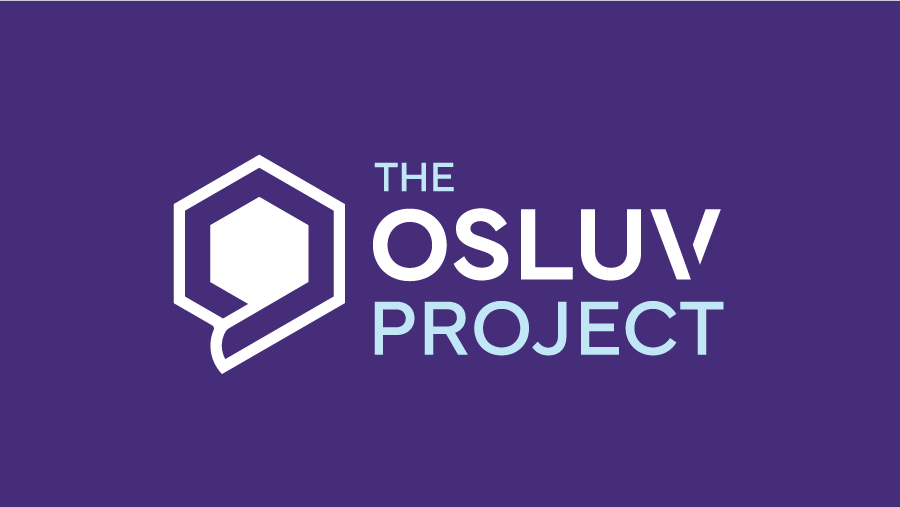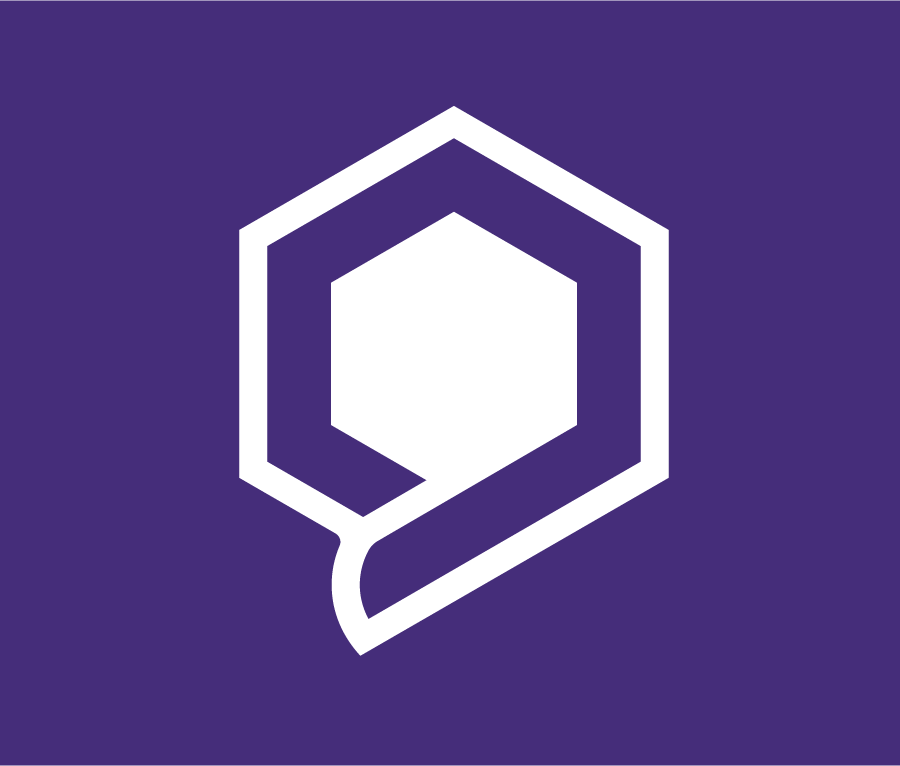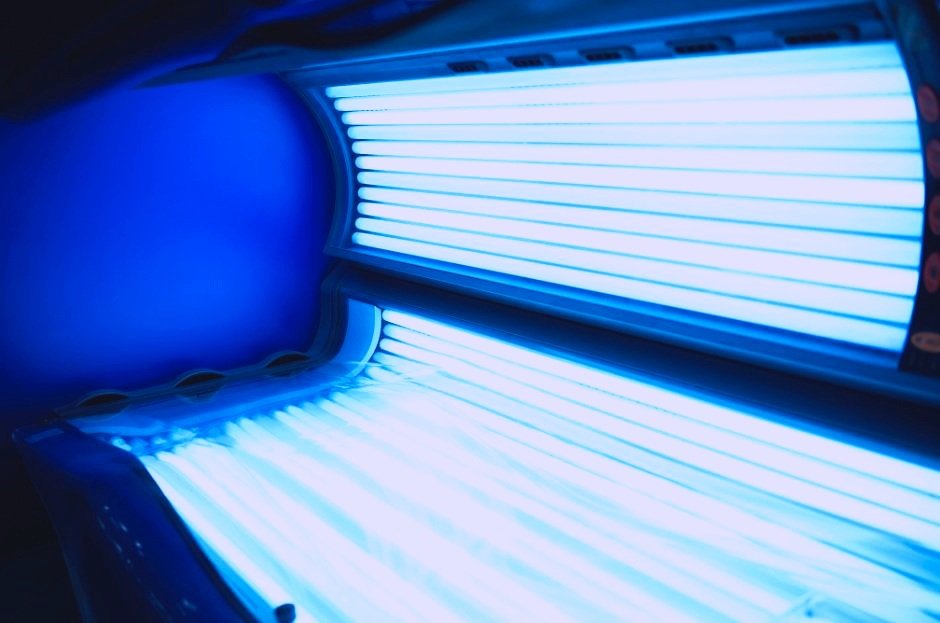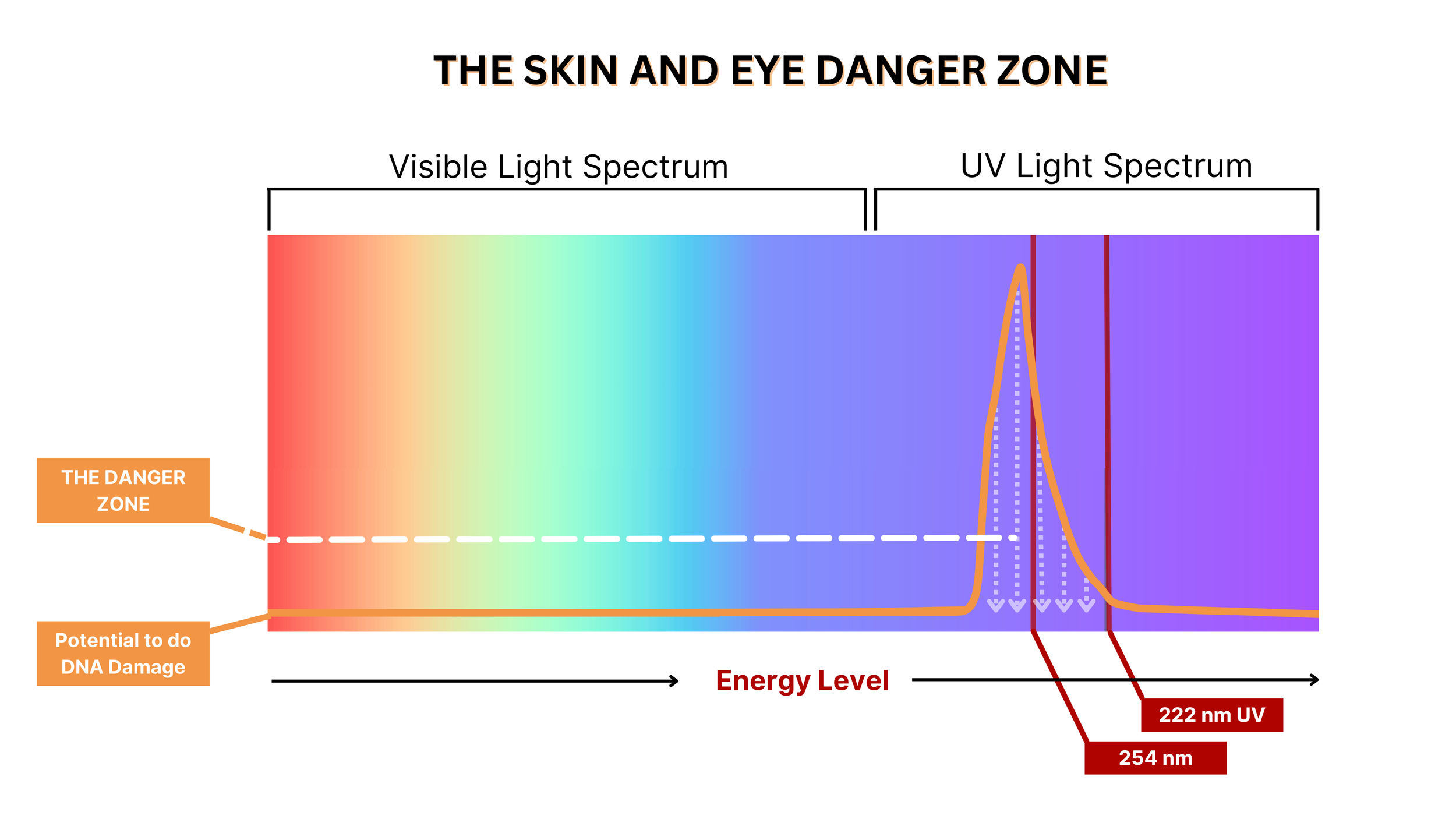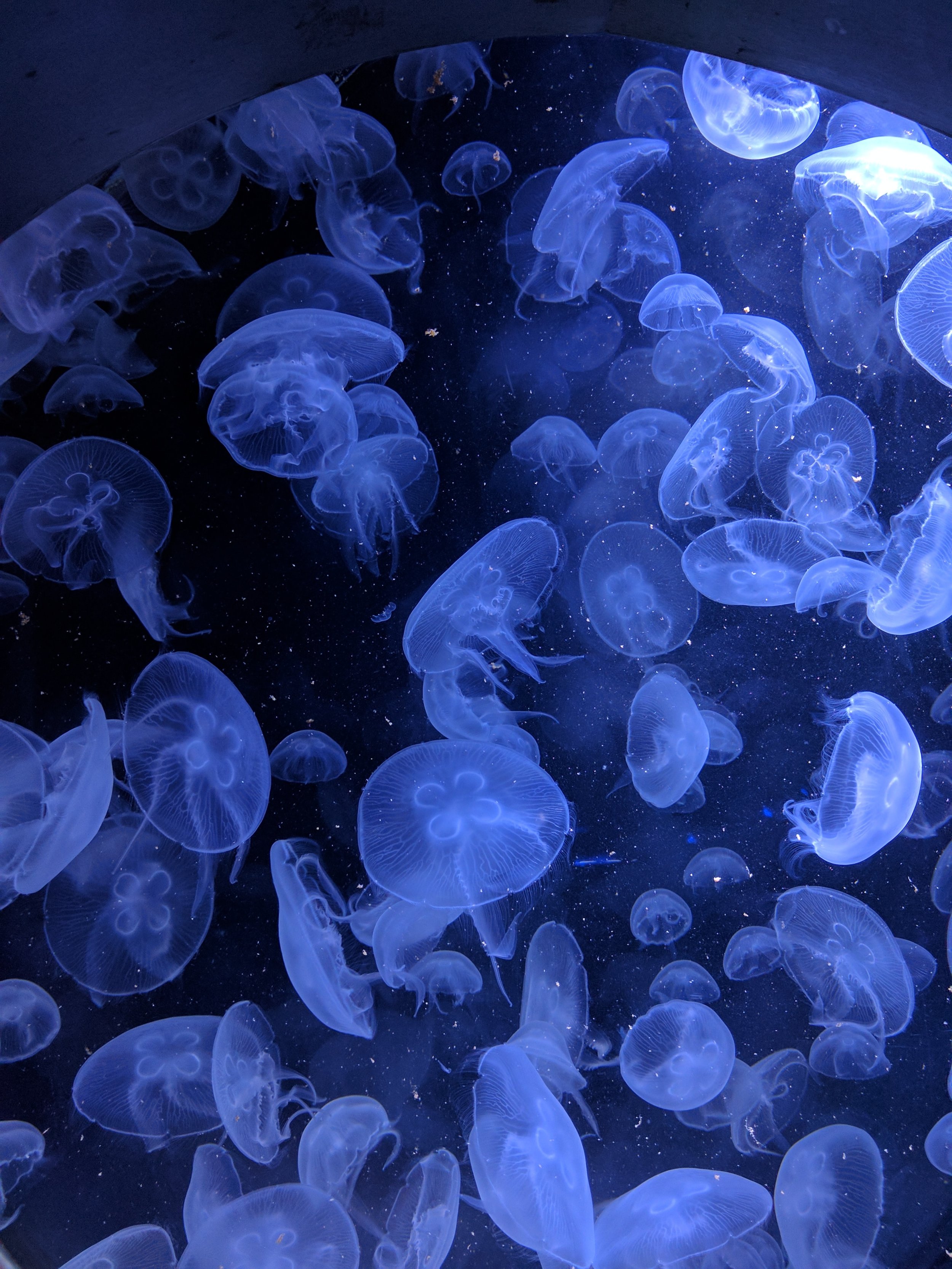
Understanding UV Light, UV Air Cleaning, and Safety Concerns
UV Air Cleaning and Safety
The Broad Spectrum Overview: What is UV Light?
UV light, like all other electromagnetic energy, is defined by its energy which is a function of its wavelengths. Longer wavelengths equate to lower energy, while shorter wavelengths carry higher energy.
While the impacts they have and the experiences they create couldn’t be more varied, visible light, UV light, x-rays, microwaves, and radio waves are all, in fact, the same thing: specific frequencies of electromagnetic energy. Visible light (or light that is perceptible with the naked human eye) is electromagnetic energy with a wavelength (or energy level) exactly the right frequency to activate specific cells in our eyes, allowing us to perceive color, brightness, dimness, etc.
Multiple forms of electromagnetic energy, including x-rays, radio waves, and ultraviolet light are all part of the electromagnetic spectrum, but are invisible to the human eye. They each are either too high- or too low-energy to reach or activate those cells in our eyes.
Their distinct wavelengths, in turn, gives these specific bands of electromagnetic energy their defining properties – radio waves from wifi routers, cell phones, and car radios are long enough to travel though our world and transmit information without causing any damage, infrared light is long-wavelength enough to be perceptible as heat, UV-light from the sun is high-energy (and short wavelength) enough to cause damage in the deep, invisible layers of the skin in the form of sunburn, etc.
UV light occupies a very specific band of the electromagnetic spectrum that is higher energy and shorter wavelength than visible light. Included in this band is a range of energy levels defined by specific wavelengths (UVA at 315-400 nm, UVB at 280-315 nm, and UVC at 100-280 nm, listed in order from longest wavelength/lowest energy to shortest/highest). Some parts of the UV spectrum are very safe for human exposure, while others carry significant risk.
Naturally Occurring UV
We interact with varying wavelengths of UV light all the time. We’re all familiar with the most common forms of UV and UV damage: light (and damage) from the sun. While invisible to us, solar UV exposure is well-understood to create changes deep within the skin and eyes, impacting the layers of both where new cells are produced, causing sunburn and permanent changes to the DNA of these new cells. These DNA changes, in turn, can cause skin aging, vision changes, and cancers including melanoma.
For these wavelengths, we know that sunscreen, sunblock, shade, UV protective clothing, and sunglasses all protect effectively against the UV damage we encounter naturally. They do this by limiting the amount (or dose) of UVA and/or UVB that reaches skin and eyes.
While UVA and UVB from the sun present skin and eye health concerns, UVC is almost entirely filtered by the atmosphere, meaning we don’t interact with naturally occurring UVC under any normal circumstances.
The ABCs of Artificial UV
UVA
While not as ubiquitous as sunlight, some types of artificial UV are very familiar. For instance, the blacklight bulbs you can buy at party suppliers emit a wavelength of UVA light very close to the visible light spectrum that is specifically intended to create an ultraviolet glow in fluorescent materials.
These are the lights used exclusively to create visual effects and are great for applications ranging from making your uncle’s velvet Elvis poster look especially cool in his basement game room, to checking antique vases for uranium content, to forensic applications.
UV lights that are designed for decorative purposes are filtered so that only the intended wavelengths escape the bulb, ensuring that your skin and eyes stay safe while your teeth and shoelaces light up the dancefloor.
UVB
Tanning beds also feature commonly-known UV lights. Primarily emitting light in the UVB wavelength range, these too are designed to filter the most acutely dangerous wavelengths of light, though it should be noted that these lights are intended to cause changes deep in the skin, producing a tan.
This is why eye protection is typically recommended to users of tanning beds, which are notoriously poorly regulated so further caution is encouraged as a significant percentage of tanning beds emit light in a range of more dangerous wavelengths.
UVC
While artificial UVC is less well-known, its application is well-established. In fact, using UVC light to sanitize pathogens in the air dates back to the mid-1900s, when Willam Wells designed and implemented a groundbreaking study effectively reducing the airborne spread of measles in Pennsylvania classrooms.
Recent news stories of temporary eye damage to those with exposure to UV light fixtures at parties highlight the high-energy and high-risk nature of these particular wavelengths of UVC. These injuries are most often caused by event venues incorrectly installing unfiltered germicidal UV and mistaking the fixtures for blacklight bulbs; appropriate filtration would eliminate these dangerous wavelengths in situations where the venue’s only goal is producing a decorative glow.
Traditional UVC pathogen sanitization works by exposing pathogens such as spores, bacteria, and viruses to very high-energy UVC light (230-300nm), causing immediate damage to the surface and DNA structure of these pathogens. This damage, in turn, inactivates the pathogen’s ability to infect cells.
Thus, those breathing the air treated by exposure to this light are significantly less likely to be infected. This property makes traditional UVC extremely effective at airborne disease control, but requires expensive and extensive maintenance and installation to ensure occupant safety. Without this careful and consistent attention, traditional UVC air cleaning can be ineffective, unsafe, or both.
It Takes 222
In recent years, a new kind of UVC pathogen inactivation technology has been developed that is both very effective AND occupant-safe. Often called “far-UVC,” these devices employ special bulbs and light filters to narrow the spectrum of UVC light leaving the lamp from the 240-300 nm emitted by traditional UV air cleaners to a much lower wavelength of 200-240 nm, centering on a target emission of 222 nm.
A well-designed UVC air cleaning lamp in this spectrum can — simultaneously — effectively clean many pathogens from air in a room and shine on the occupants of that same room. This shorter wavelength band of UVC can penetrate the comparatively delicate outer layers of viruses and other pathogens, but cannot meaningfully pass through the outer layers of the human skin or eye. In many ways, the human body has a sort of built in “sunscreen” to these wavelengths of UV. Far-UVC is short-wavelength enough that the dead cells and lipids that make up the outer layers of the skin and eye absorb almost all of the UV energy before it can affect the live and reproducing layers of tissue.
This safeguard, combined with strategic dosing limits, makes far-UVC a prime candidate for fulfilling our goals at The OSLUV Project: occupant-safe, whole room, easily-installed air cleaning that can make gathering joyful, safe, and accessible with minimal effort.
UV and Skin and Eye Safety
So what exactly accounts for how much more occupant-safe far-UVC is than traditional UVC for air cleaning? The answer, in many ways, is luck.
In addition to the protection provided by artificial shields such as sunblock, UV-blocking glasses, clothing, and even shade, the human body has some natural protections against acute damage from low doses of longer wavelength UV light, like the UVB light from the sun.
For instance, the melanocytes that account for tanning and eye color produce pigment (called melanin) that helps to shield the deepest layers of the skin from UV radiation. While significant damage still occurs at these wavelengths (see: sunburn, skin aging, cancer, and vision changes) at higher doses, our bodies have adapted to absorb small doses of the UVA and UVB it encounters before it reaches the depth of tissue where damage to the DNA of replicating cells is likely.
Since naturally occurring UVC is filtered by the atmosphere before reaching the Earth’s surface, humans have had no evolutionary need to develop biological protections against these shorter wavelengths of UV. This accounts for why traditional UVC air cleaning can so easily cause concerning skin and eye damage at such relatively low doses: our natural capacity to absorb the UV energy before it can cause DNA damage to the replicating layers of tissue begins to falter as energy increases and wavelength decreases (notable around 300 nm).
The science is still very active in this space, but we know that this risk reduction is largely the product of the very outer layers of the skin and eye. The epidermis – or the tissue-forming outer layer of the skin – itself has an outermost-layer called the stratum corneum.
The stratum corneum, the layer of skin we touch and see and regularly slough off, is largely composed of skin oils and dead cells. This layer is approximately as deep as one-third the width of a human eyelash.
It acts as a sort of far-UVC “sunscreen,” absorbing the vast majority of UVC energy and preventing any UVC energy from reaching the DNA replicating layer of the skin.
By happenstance, though, around 260 nm, the wavelengths become small enough that less and less light (and thus less and less energy) can reach these same critical depths of tissue. These two factors combine to create a “danger zone”: a band of UV wavelengths that are acutely effective at both penetrating to the replicating layers of the skin and causing DNA damage there even at very low doses. Traditional UVC air cleaning wavelengths land in much of this band, which is why they must always be installed where they cannot shine directly on the occupants of a room.
Far-UVC, though, lives on the very edge of this curve. While 10% of energy emitted by 254 nm UVC can reach the basal cell layer, none of the energy emitted by 222 nm UVC can transgress that layer. While 254 nm UVC is more effective at cleaning pathogens from the air at lower doses, human skin and eye tissue tolerates much higher doses of 222 nm UVC. This makes far-UVC a very beneficial option in situations where temporary installation or whole room air-cleaning are required.
Eye safety is harder to study definitively, but current studies indicate that the eye is protected from commonly recommended doses of far-UVC by its own outer layer.
This layer, called the tear film, is composed of lipids, water, sloughing cells, and mucin. The tear layer is as deep as the width of one-eighteenth of a human eyelash.
It seems that the cornea, the part of the eye damaged by traditional bands of sanitizing UVC, is protected by the absorption of the tear film.
Both traditional UVC and far-UVC air cleaning can be deployed safely and responsibly. Measures must be taken to ensure exposure and dose are within safe limits. In the case of traditional UVC air-cleaning, this simply means installing it where the air can circulate thoroughly and quickly without shining on occupants.
Typically these systems are installed in the upper-room, as was the case in Wells’ Pennsylvania classroom, or in the HVAC system itself. However, these installation needs mean that UVC has — until now — been restricted to use in permanent, hard-wired locations, tended to by specific professionals. Far-UVC provides opportunities to deploy this potentially life-saving technology quickly, temporarily, and more accessibly.
It is also worth noting that PPE and even normal clothing can help prevent exposure to unsafe doses of UVC. Clothing, glasses, hair, and even some body products can help lower the exposure dose via absorption or reflection.
